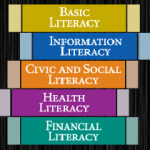by Melissa Correll, Instructional Services Librarian, Lycoming College
Currently reading Cool: How the Brain’s Hidden Quest for Cool Drives our Economy and Shapes our World by Steven Quartz and Anette Asp
On Wednesday, July 29th, more than 100 librarians converged at Penn State University’s Paterno Library to participate in the third annual PA Forward Information Literacy Summit. Presentation slides are available on the PA Forward Information Literacy Summit page on the PaLA website. With this year’s theme of “Framing the Value of Information Literacy,” it is no surprise that several presentations focused on the Framework.
ACRL Framework for Information Literacy for Higher Education: Understanding the ACRL Framework for Student Learning
Merinda Kaye Hensley gave the first keynote address, “ACRL Framework for Information Literacy for Higher Education: Understanding the ACRL Framework for Student Learning.” Hensley serves as Instructional Services Librarian and Scholarly Commons Co-Coordinator at University of Illinois at Urbana-Champaign. She is also the Chair of ACRL’s Student Learning and Information Literacy Committee, and she served on the Task Force that developed the Framework. Because she was so close to the process of developing the Framework, I was surprised to hear her suggest that librarians may struggle to use the Framework to assess student learning. On April 9th, she tweeted “You will never be able to prove a student crossed a threshold. There. I said it.” In another tweet on the same day, Hensley writes, “What you CAN do is assess students’ understanding of elements within a [Threshold Concept].”
Instead of wresting the Knowledge Practices or Dispositions into assessable learning goals, Hensley advised finding a practical approach that suits the unique needs of your students, instruction program, and institution. She said “The key to effectively using the Framework is writing your own learning outcomes.” Hensley described instances when she had done just that. History students visited the Archives to discover the narrative about a historical event in primary sources. The students then compared how the event was covered in its time to how it is presented today. This applies to the Frame ‘Authority is Constructed and Contextual,’ but the learning outcomes for the class were more specific. Students learned that they are allowed to use the Archives, what kind of materials they will find there, and what a primary source is.
Hensley suggested using backward design techniques to write your own learning outcomes, with the Framework as a guide. Consider the cognitive, behavioral, and affective aspects of learning. What do you want students to know? What do you want them to be able to do? What would you want them to think about or care about? Hensley mentioned the importance of including the affective dimension in your learning objectives, to treat the student as a whole person and recognize the anxieties students often feel about the research process.
Making the Model Curriculum Work for You: It’s Not Just for the Runway Models
It is natural for students to feel anxiety about college-level research; first-year students come from diverse backgrounds and have vastly different levels of experience and skill in using libraries. There are 500 school districts in Pennsylvania, and they all teach information literacy in their own way. Some students visit the library regularly, some get direct instruction with a librarian, while other students do not have a library in their school at all. While not a silver bullet, the PA Model Curriculum for Pennsylvania School Library Programs is designed to help K-12 librarians teach students the information skills they will need for college and careers. This was the focus of the second keynote, “Making the Model Curriculum Work for You: It’s Not Just for the Runway Models,” presented by Allison Burrell, Vice President of PSLA and District Librarian and Media Specialist, Southern Columbia Area School District and Cathi Fuhrman, Hempfield School District Library Department Supervisor.
The Model Curriculum is organized around Big Ideas in information literacy, and aims to develop students’ skills incrementally over the course of their schooling. To that end, Competencies are organized as what Burrell called “stairs of complexity,” meant to challenge students and give them opportunities to demonstrate mastery in a way that is appropriate for their grade level. Like the Framework, the Model Curriculum includes cognitive, behavioral, and affective dimensions of learning, and the Competencies reflect what students should know, understand, and be able to do. Furhman shared her own exercise in crosswalking the Model Curriculum’s Big Ideas to the Framework. While this is a work in progress, Furhman indicated that she intends to make the document available along with the presentation slides.

